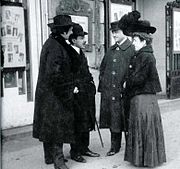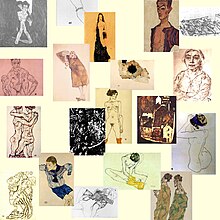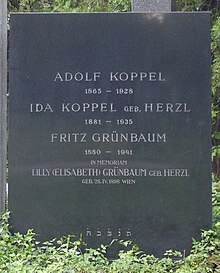Fritz Grünbaum
Fritz Grünbaum , also Fritz Gruenbaum , actually Franz Friedrich Grünbaum (born on April 7, 1880 in Brno , Austria-Hungary ; died on January 14, 1941 in Dachau concentration camp ), was an Austrian cabaret artist , operetta and hit writer, director , actor and Emcee .
Life
Grünbaum experienced his childhood and youth with his family in Brno, who ran an art trade. At the age of 18, he enrolled in a law degree in Vienna . He graduated with an Absolutorium , and his interest in literature grew during his studies . After completing his studies, he began as a master of the Viennese cabaret Hölle , where he made his first appearance in the operetta Phryne in 1906 . From 1903 he wrote libretti with Robert Bodanzky and others and appeared as an actor in various supporting roles on many Viennese basement stages and revue theaters .
Until the outbreak of the First World War , he also traveled to Berlin again and again - for the first time in 1907 to appear in "Chat Noir" - to act there as an emcee in Rudolf Nelson's theaters. - Nelson about Grünbaum: "[...] when he didn't speak, he looked like a pitiful creature, a nothing, lost between the scenes. But - when he opened his mouth - a 'fireworks display of the brain'. He shoots his joke rockets and bon mots non-stop with over-the-top logic into the surprised parquet. Famous talent! Much too good for Vienna […] ”.
In 1914 Grünbaum had his first appearance in Simpl , a legendary Viennese cabaret. After the First World War he often appeared again in the Simpl. Together with Karl Farkas , from 1922 he developed the “ Double Conference ” from Hungary (and which was also shown in the “ Budapest Orpheum ” in Vienna ) and led it to a heyday (with the roles of “Gscheiten” and “Stupid”; Farkas explains to his partner: "The essence of the double conference is that you take an extremely intelligent, good-looking man - that's me - and add a second, the stupid one. That's, according to all the rules of human physiognomy, of course you!" ").
Grünbaum was described by acquaintances as an "enchanting contemporary". In 1910 he slapped a k. u. k. Officer in the pub "Hell" when he shouted anti-Semitic slogans in the middle of the program. Then he continued his performance. Later the officer challenged Grünbaum to a duel "on saber and pistols" in which Grünbaum was wounded.
Grünbaum went to the First World War on February 1, 1915, after volunteering for military service . In the spring of 1916 he fought on the Italian front , returned disaffected (with the rank of first lieutenant) and from then on also attracted attention with pacifist statements.
Grünbaum was married to Carli Nagelmüller, born Karolina Nagelmüller , from 1908 to 1914 . In 1916 he married a colleague Mizzi Dressl and on November 10, 1919 then Lilly Herzl (Elisabeth, niece of Theodor Herzl ), with whom he stayed together until the end. Lilly Herzl was able to hide for a while with a friend in Vienna, Elsa Klauber, and was then deported together with her friend to the Maly Trostinez extermination camp on October 5, 1942 , where she died four days later.
From 1926 Grünbaum worked at the Vienna Citizens' Theater. In 18 pictures he and Karl Farkas had Egon Neumann's music in the Journal of Love show beautiful women their legs and Rita Georg paraded in a trouser role . The play Wien laughs again , which began on October 1, 1926, also fitted into this scheme . In thirty pictures Grünbaum and Karl Farkas (music by Ralph Benatzky ) performed last year's hit revue, which had lost none of its popularity. There were 120 participants and 900 costumes. The piece was performed for a year.

Grünbaum commuted very often between Berlin and Vienna. In Berlin he appeared in films and wrote texts for Schlager and wrote scripts, in Vienna he worked in various cabarets. In 1933 his texts became more political in Vienna. During one of his last appearances in the Viennese cabaret Simpl in the program Metro Grünbaum - Farka's sneering newsreel , he joked when the lights went out when there was a power failure: "I don't see anything, absolutely nothing, I must have lost my way into National Socialist culture." On March 10, 1938, the day before the German troops marched into Austria , he played with Karl Farkas one last time in Simplicissimus . Thereafter, the Reich Chamber of Culture issued a performance ban for Jewish artists. A day later, Grünbaum tried to flee to Czechoslovakia with his wife , but was turned away at the border. For a while he hid in Vienna; then he was betrayed and deported to the Dachau concentration camp on May 24, 1938 . Later he was brought to Buchenwald and finally back to Dachau. He died - according to the death certificate, "with cardiac paralysis" - on January 14, 1941 in the Dachau concentration camp, after performing one last time in front of his fellow sufferers on New Year's Eve. He died exhausted from tuberculosis, but his pointed tongue did not stop until the end. He conferred, for example, on how he intended to defeat the “millennial empire” or that complete deficiency and systematic starvation were the best remedy for diabetes. When a concentration camp guard refused him a bar of soap, Grünbaum replied: “If you have no money for soap, you shouldn't keep a concentration camp”. His grave is in the Vienna Central Cemetery (1st gate; old Israelite part, group 20, row 23, grave no.22).
Art collection & restitution
Fritz Grünbaum was a well-known art collector - especially of Austrian modernism - whose works were represented in famous catalogs and exhibitions. The sales route and whereabouts of the works of art and its library have not yet been clarified and only partially restituted . His art collection comprised over 400 works, which are described by an appraisal report by Franz Kieslinger in 68 items, in some cases in majorities of works. This appraisal report suggests a total of 446 works, including a high proportion of graphics. The collection contained over 80 works by Egon Schiele . Furthermore were u. a. Albrecht Dürer , Rembrandt van Rijn , Max Oppenheimer , Edgar Degas , Carl Spitzweg , Oskar Kokoschka and Käthe Kollwitz were represented. The whereabouts of the collection during the Nazi era is unclear, 25% of the collection reached the art market in the early 1950s via the Swiss art dealer Eberhard W. Kornfeld . The fate of the rest is unknown.
Grünbaum's heirs have been fighting for the restitution of works formerly in his collection for years; however, they have often been thrown back. In 2005, an application to restitute Schiele's "Seated Woman with a Curved Left Leg (Torso)" was rejected. The court found that too much time had passed before Grünbaum's heirs could claim.
In 2015, Grünbaum's heirs began the process of returning Schiele's "Woman in a Black Apron" (1911) and "Woman, Hiding Her Face" (1912). Thanks to the HEAR Act, restitution was ordered, as Judge Ramos stated in his judgment: The HEAR Act forces us to help ensure that the art stolen by the Nazis is returned to their heirs [...] the heartbreaking process through which Mr. Grünbaum's property was looted. (The HEAR Act compels us to help return Nazi-looted art to its heirs […] the gut-wrenching process by which Mr. Grünbaum's property was looted)
Continue to work
Grünbaum lived in Vienna 1., Wollzeile 36, in the house of the Simpl cabaret , where a plaque commemorates him. ( Michl Schwarz , among others, lived in the same house .)
Fritz Grünbaum was right with his fundamental pessimism : “What use is my mind if my name harms me? / A poet whose name is Grünbaum is already done for! ”In Dani Levy's film Mein Führer - The Truly Truth About Adolf Hitler , Grünbaum is placed an artistic monument in the main character Adolf G. The changed first name "Adolf" naturally has a meaning. Rotthaler says, “Via Fritz G. you can get to the secret center of Levy's melancholy grotesque. [...] Because of course the good old double conference is hidden behind the [...] game [...]. "He quotes the New York structure , which wrote on the occasion of Grünbaum's murder in Dachau:" The most terrible thing was that he was less like a Dachau Prisoner looked more like a Dachau prisoner, played by Fritz Grünbaum. One was prepared for a farce and it was a tragedy. "
Honors
- 1968: In Vienna's 22nd district, Donaustadt , the green tree alley named after him.
- 1989: Fritz-Grünbaum-Platz in the 6th district, Mariahilf , was named after him.
- A star in the Cabaret Walk of Fame is dedicated to him.
- A memorial plaque was attached to Grünbaum's house 1., Wollzeile 36, where the Simpl cabaret is located.
Works (selection)
Operettas, plays
- Peter and Paul travel to the land of milk and honey. With Robert Bodanzky , music: Franz Lehár , 1906.
- Phyme. With Robert Bodanzky, music: Edmund Eysler , 1906.
- The dollar princess . With AM Willner, music: Leo Fall , 1907.
- Mitislaw, the modern. With Robert Bodankzky, music: Franz Lehár, 1906.
- The love waltz. With Robert Bodanzky, 1908.
- Miss the bagpipes . With Hans Reichert, music: Rudolf Nelson , 1909.
- The musician girl. With Wilhelm Sterk , music: Georg Jarno , 1910.
- The gypsy primes . With Julius Wilhelm , music: Emmerich Kálmán , 1912.
- Storm idyll. Comedy, 1914.
- My Annerl. With Wilhelm Sterk, music: Georg Jarno, premiered in Vienna in 1916.
- The favourite. With Wilhelm Sterk, music: Robert Stolz , premiered in Berlin in 1916.
- A modern girl. With Wilhelm Sterk, music: Leon Jessel , 1918.
- The Czikosbaroness. Music: Georg Jarno , premiere 1919 in Hamburg.
- The king's neighbor. With Wilhelm Sterk, music: Leon Jessel, 1923.
- World history compliant. Revue. With Armin Friedmann , music: Stephan Weiss, Willy Engel-Berger u. a., 1928
- Dream express. With Karl Farkas, 1931.
- The creation. Cabaret pieces.
- Hell in heaven. Cabaret.
- The quiet wise one.
Songs
- There under the tree. Chanson in Volkston, music: Willy Kunkel , 1912, Drei Masken Verlag
- Henriette Lied and Foxtrot, music: Richard Fall , 1927, Wiener Bohême Verlag
- Outside in Schönbrunn Wiener-Lied, with Karl Farkas , music: Ralph Benatzky, 1926, Wiener Bohême Verlag
- Just don't take a woman from the Mississippi song and foxtrot, music: Richard Fall, 1927, Wiener Bohême Verlag
- When I look into your false eyes ... Lied and Tango, music: Richard Fall, 1927, Wiener Bohême Verlag
- I saw Miss Helen bathe Music: Fred Raymond
Filmography
as an actor, unless otherwise stated
- 1929: Melody of the Heart (lyrics only)
- 1931: The robbery of the Mona Lisa
- 1931: My wife, the impostor
- 1931: The good sinner
- 1931: As poor as a church mouse
- 1932: For once I don't want to worry
- 1932: A song, a kiss, a girl
- 1932: Man without a name
- 1932: It's getting better again
- 1932: girls to marry
- 1934: Peter
Works by Grünbaum - reissued after his death
- The cabaret is my ruin . 2 CDs (CD1: Chansons, conferences and texts by (and with) Fritz Grünbaum. CD2: Feature about Fritz Grünbaum by Volker Kühn ). Edition Mnemosyne, Verlag für Alte Hüte & Neue Medien, Neckargemünd / Vienna, 2005, ISBN 3-934012-23-X .
- Fritz Grünbaum: Hello, this is Grünbaum! Edited and with a biographical foreword by Pierre Genée, Löcker Verlag, Vienna / Munich 2001, ISBN 3-85409-330-6 .
- Fritz Grünbaum: The creation and other cabaret pieces. With a cabaret preface by Georg Kreisler . Ed. U. with e. biographer. Nachw. By Pierre Genée and Hans Veigl . Löcker Verlag, Vienna / Munich 1984, ISBN 3-85409-071-4 .
- Fritz Grünbaum: The quiet wise one. Poems and monologues from the repertoire . Published by Hans Veigl. Vienna 1992, ISBN 3-218-00552-3 .
Literature on Grünbaum
- Marie-Theres Arnbom , Christoph Wagner-Trenkwitz (Ed.): Greet me God! Fritz Grünbaum. A biography 1880–1941 . Christian Brandstätter Verlag, Vienna 2005, ISBN 3-85498-419-7 .
- Felix Czeike : Historical Lexicon Vienna. Volume 2: De-Gy. Kremayr & Scheriau, Vienna 1993, ISBN 3-218-00544-2 (with wrong date of death "1940").
- Ernst Federn : Fritz Grünbaum's 60th birthday in the concentration camp. In: Roland Kaufhold (Ed.): Ernst Federn - Attempts on the psychology of terror. Psychosozial-Verlag, Giessen 1999, ISBN 3-932133-47-1 , pp. 95-97.
- Susanne Blumesberger, Michael Doppelhofer, Gabriele Mauthe: Handbook of Austrian authors of Jewish origin from the 18th to the 20th century . Volume 1: A-I. Edited by the Austrian National Library. Saur, Munich 2002, ISBN 3-598-11545-8 .
- Ulrich Liebe: Adored, persecuted, forgotten: actors as Nazi victims. Quadriga, Weinheim 1992, ISBN 3-88679-197-1 .
- Sophie Lillie : What once was. Handbook of the expropriated art collections of Vienna. Czernin Verlag, Vienna 2003, ISBN 3-7076-0049-1 .
- Hans Veigl : drafts for a green tree monument. Fritz Grünbaum and the Viennese cabaret. Austrian Cabaret Archive , Graz / Vienna 2001, ISBN 3-9501427-0-3 .
- Kay Less : 'In life, more is taken from you than given ...'. Lexicon of filmmakers who emigrated from Germany and Austria between 1933 and 1945. A general overview. ACABUS-Verlag, Hamburg 2011, ISBN 978-3-86282-049-8 , p. 218 f.
- Hans Veigl : Fritz Grünbaum and the Viennese cabaret. Biography & Reader. Austrian Cabaret Archive, Graz 2019, ISBN 978-3-9504628-8-3 .
Web links
- Literature by and about Fritz Grünbaum in the catalog of the German National Library
- Entry on Fritz Grünbaum in the Austria Forum (in the AEIOU Austria Lexicon )
- Fritz Grünbaum in the Internet Movie Database (English)
- Entry for Fritz Gruenbaum in The Central Database of Shoah Victims' Names
- Entry for Elisabeth Grünbaum in The Central Database of Shoah Victims' Names
- Memorial sheet for Elisabeth Grunbaum in The Central Database of Shoah Victims' Names
- "Grüß mich Gott", Grünbaum vita of Marie-Theres Arnbom
- Welt-Artikel: "What use is my spirit"
- Fritz Grünbaum at cyranos
- Pictures by Fritz Grünbaum In: Virtual History
- Fritz Grünbaum on the website of the Austrian Cabaret Archive
- Ernst Federn on Fritz Grünbaum's 60th birthday in the concentration camp
- German Cabaret Archive (PDF file; 79 kB)
- Blog on the restitution of Fritz Grünbaum's art collection
- Works by Fritz Grünbaum in the Gutenberg-DE project
Footnotes
- ↑ Marie-Theres “GREET ME GOD!” , On christenundjuden.org, accessed on February 6, 2019
- ↑ Christoph Wagner-Trenkwitz, Marie-Theres Arnbom: Grüß mich Gott! Fritz Grünbaum 1880–1941. Brandstätter, 2005, ISBN 3-85498-393-X .
- ↑ a b c Karin Ploog: … When the notes learned to run… History and stories of popular music up to 1945. Second part: composers - librettists - lyricists from cabaret - operetta - revue - film. Volume 1.2. Books on Demand, Noderstedt 2015, ISBN 978-3-7347-4718-2 , p. 309 ( limited preview in Google book search).
- ↑ Exile archive
- ^ Walter Fritz: In the cinema I experience the world - 100 years of cinema and film in Austria. Bundesverlag, Vienna 1996, ISBN 3-85447-661-2 , p. 146.
- ↑ Dachauer Hefte , Volumes 23-25, Verlag Dachauer Hefte, 2007, p. 91 ( limited preview in the Google book search).
- ↑ https://artstolenfromfritzgrunbaum.files.wordpress.com/2009/06/1938-27-04-kieslinger-inventory.pdf
- ^ Team, The. "Search the Collection Gruenbaum". Collection Gruenbaum. Att. Raymond J. Dowd.
- ↑ https://artstolenfromfritzgrunbaum.files.wordpress.com/2013/04/2012-10-11-summary-order-negative-schlussentendung.pdf
- ↑ https://artstolenfromfritzgrunbaum.files.wordpress.com/2015/11/20151118-heirs-of-holocaust-victim-sue-art-dealer-over-works-_-new-york-post.pdf
- ↑ Keener, Katherine. "Dissecting the HEAR Act: the US's law streamlining the restitution of art stolen during WWII". Looted Art. Commission for Looted Art in Europe.
- ↑ Viktor Rotthaler: Spring for Hitler. Dani Levy's historical role models. In: Frankfurter Rundschau. January 13, 2007, p. 15.
- ↑ Richard Weihs online presence Richard Weihs : A Monument for Fritz Grünbaum
| personal data | |
|---|---|
| SURNAME | Grünbaum, Fritz |
| ALTERNATIVE NAMES | Gruenbaum, Fritz; Grünbaum, Franz Friedrich (real name) |
| BRIEF DESCRIPTION | Austrian cabaret artist, operetta and hit writer, director, actor and emcee |
| DATE OF BIRTH | April 7, 1880 |
| PLACE OF BIRTH | Brno , Austria-Hungary |
| DATE OF DEATH | January 14, 1941 |
| Place of death | Dachau concentration camp |





